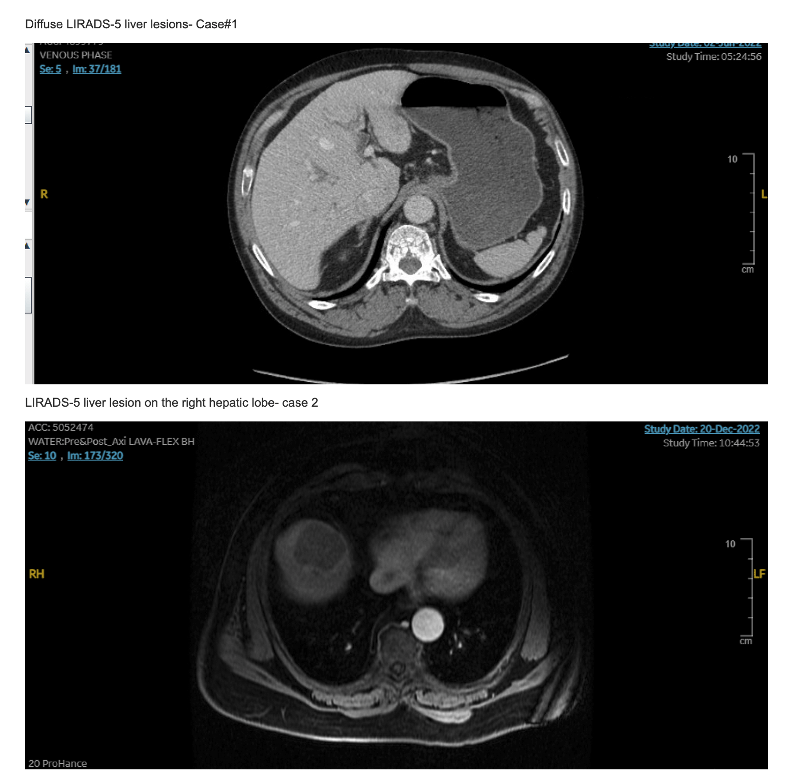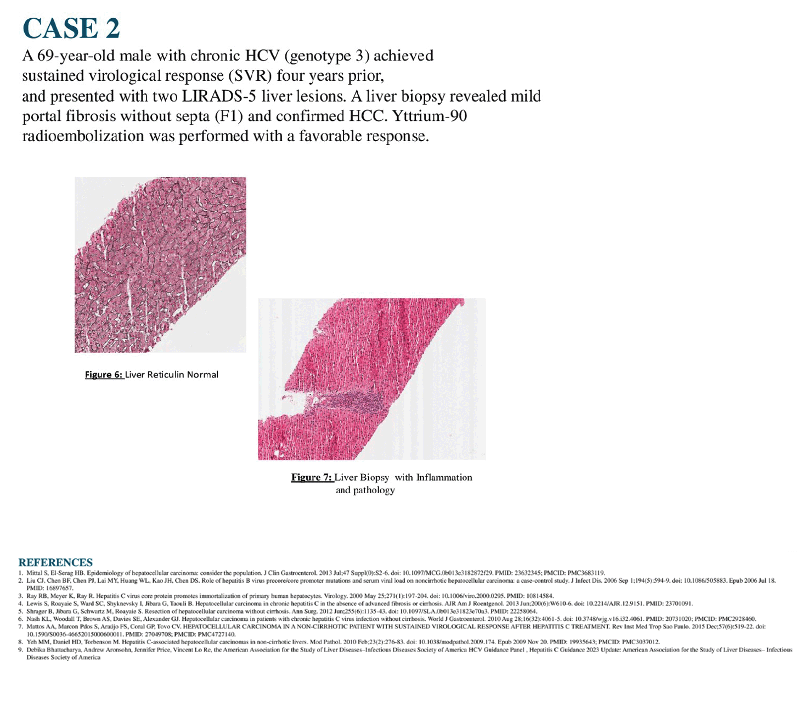 |
 |
 |
| |
DE NOVO HEPATOCELLULAR CARCINOMA (HCC) IN NON-CIRRHOTIC CHRONIC
VIRAL HEPATITIS C (HCV) PATIENTS: A CASE SERIES
|
| |
| |
Download the PDF here
Dr. Mina Awadallah
Author(s): Mina Awadallah, Ali Wakil, Camelia Ciobanu, Amr Dokmak, Jeeva Jaganathan, Arnold Forlemu, Vijay Gayam, Praneeth K. Bandaru, Madhavi Reddy
ABSTRACT
Introduction:
Chronic hepatitis C (HCV) is one of the leading risk factors for hepatocellular carcinoma (HCC), usually through the development of advanced fibrosis and cirrhosis. However, chronic HCV without cirrhosis leading to HCC is extremely rare and has been reported to occur in less than 1.5% of this population. We present two cases of HCV without cirrhosis who presented with HCC.
Case 1:
A 67-year-old male with a history of chronic myeloid leukemia (CML) in remission, chronic HCV (genotype 1b, treatment-naive, HCV RNA viral load 72,400 IU/mL) referred to hepatology practice for HCV treatment. On abdominal imaging the patient was found to have 5 LIRADS-5 liver lesions on multiphasic contrast-enhanced CT abdomen) Transjagular liver biopsy was obtained and a biopsy sample the background liver and the liver lesions. Pathology showed mild portal fibrosis without septa consistent with fibrosis stage 1 = F1. portal pressure with a hepatic venous portal gradient of 4 mmHg. Pathology of the liver lesions confirmed hepatocellular carcinoma, moderately differentiated. The patient underwent hepatic resection by hepatobiliary surgery. He subsequently underwent HCV treatment with direct-acting antivirals and achieved sustained virological response.
Case 2:
A 69-year-old male with a history of chronic hepatitis C virus (genotype 3, SVR achieved 4 years before presentation, HCV RNA viral load is undetectable), no prior history of cirrhosis who was referred to hepatology practice for new liver lesion. Multiphasic contrast-enhanced abdominal imaging showed 2 LIRADS-5 lesions (HCC), The patient underwent a liver biopsy of the background liver and the liver lesion. Pathology showed preserved hepatic architecture and mild portal fibrosis without septa (F1), pathology of the liver lesion revealed hepatocellular carcinoma, and the Alpha-fetoprotein level is 19,840 ng/mL. The patient underwent successful Yttrium-90 radioembolization with follow-up imaging showed non-viable lesions.
Discussion:
The incidence of HCC in non-cirrhotic HCV patients is extremely low, there have been reports of oncogenic effects of HCV genotype 3 especially in patients without SVR. Our two cases revealed biopsy-proven HCC in patients without advanced fibrosis in both cases. This raises the question of an alternative mechanism behind HCC development in this patient population. Chronic HCV is proposed to have liver cell injury with inflammation, and necrosis leading to oxidative DNA damage. This process can activate oncogenesis, angiogenesis, and growth factors while inactivating tumor suppressor genome.
Conclusion:
The possibility of developing HCC in non-cirrhotic HCV patients even without advanced fibrosis raises the question regarding the need to perform closer screening/follow-up of these patients, even after SVR. Further studies to confirm these findings are needed.



|
| |
|
 |
 |
|
|